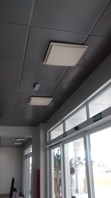
Protection of towels and robes
In Lithuania, only a few people decide to install towels and (or bathrobes) protection. In this post, you will find a brief description of how it works and how this security differs from standard security gates used in stores.
The equipment operates at UHF (865-928 MHz) frequency, with a maximum scanning range of up to 6-8 meters. It depends on the size of the tag used and the antenna (the bigger the antenna, the further the tag can be read).
The scanning distance also depends on how the equipment is configured and the power of the antennas used. Usually, 4 antennas can be connected to one UHF type reader.
It is ideal when the antennas are placed vertically on the wall and are directed towards the passage. If necessary, they can be installed on the ceiling or simply hidden under the ceiling.



Three types of tags can be used:
- Ceramic - their scanning distance is short, but they are extremely resistant to washing and high temperatures;
- Silicone - their antenna can be very large and a long distance can be obtained. But hemming them in a towel or robe is the most difficult. The price of this type of tags is the highest;
- Fabric - they are immediately in a material sheath and their antenna is of the wire type. The scanning distance of this type of tag is not as great as silicone tags can be, but considering the price, scanning distance and ease of insertion, it is a worthy choice;





Standard shop security systems work for max distance of 2 meters, and the safety markers of store goods are not intended for washing. In most cases, they are large.
The biggest difference between store product protection solutions and UHF-type protection solutions is that UHF-type identifiers can be unique: it is possible to distinguish a specific product from the entire group of products. Also determine who can and who cannot cross the exit zone. If necessary, each item can be tracked separately. Meanwhile, storefront solutions see everything simply as a uniform identifier.